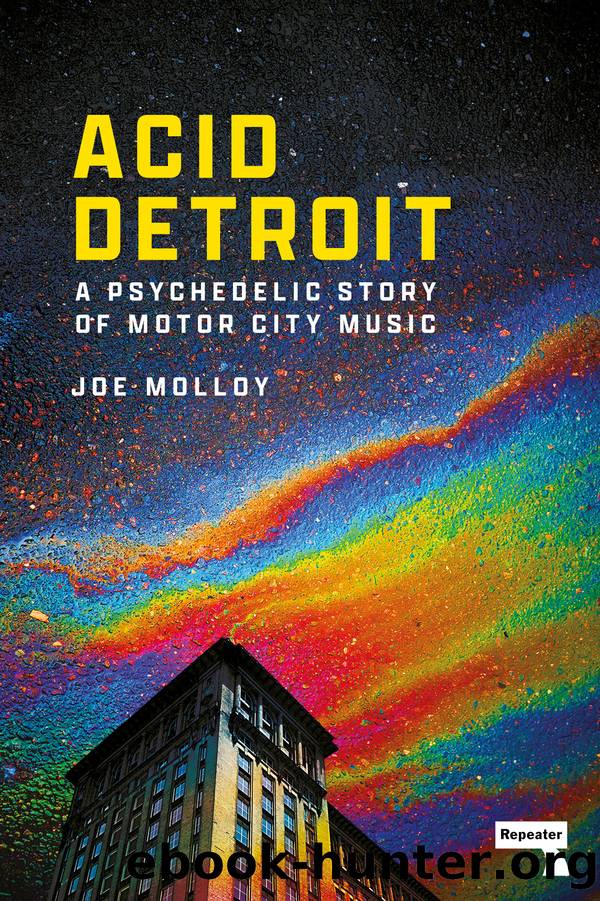Acid Detroit by Joe Molloy

Author:Joe Molloy
Language: eng
Format: epub
ISBN: 9781914420528
Publisher: Watkins Media
Published: 2023-06-15T00:00:00+00:00
Night Moves, Necros and Need for a Scene
Seger and his Detroit peers had put the cityâs music scene into a slick but profitable holding pattern by the late Seventies, and for many in Detroit, there was a growing restlessness and need for some new blood. Disaffected youth were searching for an attitude and an aesthetic that could look, if not to the future, then at least at the increasingly crumbling present and vent their frustration. Arriving from Ohio, delinquent punks Necros expressed just that, with an approach that was a complete distillation of adolescent snottiness and refusal. The bandâs 1979 Ambionic Sound is complete with teenage rippers such as âI Hate My School,â âPeer Pressure,â and âPublic School.â Nestled among these adolescent ragers are two politically tinted cuts that despair at how little progress had been made since the Civil Rights movement: âPolice Brutalityâ and âRace Riot.â The former would turn out to be a staple recording for the band, appearing on the 1981 Sex Drive 7â and 1983 LP Conquest for Death. Though they are seldom given credit, the groupâs speedy playing and raw rage on these early releases are among the founding documents of hardcore punk. Around this same time, the teenage Necros befriended scene legend Tesco Vee, founder of influential hardcore bastion Touch and Go Records and front man of Detroit band the Meatmen. At the same time, John Brannon entered the fray, whose career we will trace in the rest of this section.
We will approach Brannonâs prolific career and series of stylistic and sonic iterations through Elizabeth Kubler-Rossâs âfive stages of grief.â First formulated in her landmark 1969 book, On Death and Dying, Kubler-Ross offers up a powerful analysis of mourning and facing our inescapable fates, and outlines the five stages of grief that people go through when grappling with their impending death or the passing of a loved one. These five stages are: denial, anger, bargaining, depression, and acceptance. Trying to exactly separate out the different strands of loss is of course fruitless and, as Iâll argue, Brannonâs musical arc plays out like a lifelong struggle of coming to terms with the melancholia of urban and personal lost futures alike, with his several bands mapping onto the corresponding phases of grief.
In getting to grips with Brannonâs singular body of work, we might also look to Frederic Jamesonâs idea of the âpolitical unconscious,â which suggests that works of art are expressions of social problems that the artists themselves may not directly identify. Thus, Jameson tells us that the criticâs job is to trace back from the work to the underlying political or social problem they attempt to âsolve,â or at least raise up to consciousness and address. In that spirit, we can ask the question: What was Brannon grieving, exactly? Perhaps his fall from grace, leaving behind the religious values of his childhood. After all, in the work of his band Laughing Hyenas, we see themes of the sacramental emerge across their discography. Or perhaps he
Download
This site does not store any files on its server. We only index and link to content provided by other sites. Please contact the content providers to delete copyright contents if any and email us, we'll remove relevant links or contents immediately.
| Appreciation | Blank Sheet Music |
| Composition | Conducting |
| Exercises | Instruction & Study |
| Lyrics | MIDI, Mixers, etc |
| Philosophy & Social Aspects | Songwriting |
| Techniques | Theory |
| Vocal |
The Goal (Off-Campus #4) by Elle Kennedy(13541)
Kathy Andrews Collection by Kathy Andrews(11726)
Diary of a Player by Brad Paisley(7487)
What Does This Button Do? by Bruce Dickinson(6133)
Assassin’s Fate by Robin Hobb(6124)
Big Little Lies by Liane Moriarty(5697)
Altered Sensations by David Pantalony(5043)
Pale Blue Dot by Carl Sagan(4907)
Sticky Fingers by Joe Hagan(4100)
The Death of the Heart by Elizabeth Bowen(3550)
The Heroin Diaries by Nikki Sixx(3492)
Beneath These Shadows by Meghan March(3261)
Confessions of a Video Vixen by Karrine Steffans(3240)
How Music Works by David Byrne(3183)
The Help by Kathryn Stockett(3082)
Jam by Jam (epub)(3020)
Harry Potter 4 - Harry Potter and The Goblet of Fire by J.K.Rowling(2984)
Strange Fascination: David Bowie: The Definitive Story by David Buckley(2797)
Petty: The Biography by Warren Zanes(2697)
